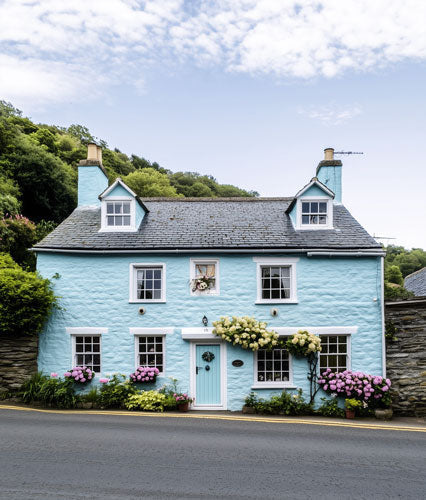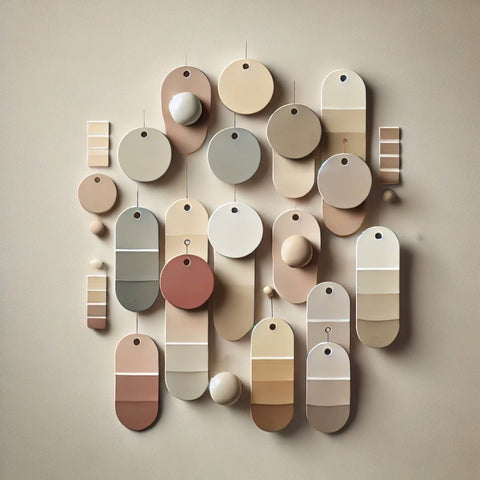If you’re deciding on the best paint products for your eco project or are researching breathable paints suitable for heritage homes, you’ve probably heard about distemper.
It’s a historic paint finish with a long history, and was widely used in Europe until the 60s when it was superseded by modern emulsions which offered better durability. Some retailers do offer distemper paints, but these tend to have adjusted formulations to make them more durable.

In this guide, we’ll explore what distemper paint is and compare it to alternatives like casein, lime, clay and silicate paints.
What is Distemper Paint?
Distemper paint was a water based paint made from minerals such as chalk or lime mixed with pigments, and with animal glue or casein used as a binder.
This traditional paint dries to a uniquely soft and powdery finish which would compliment many historic interiors. It was commonly used in stately homes, churches, and other heritage buildings.
Distemper formulation is highly breathable, making it very suitable for properties with solid walls or breathable plasters such as lime. However, traditional distemper lacks durability meaning it can rub off easily, can’t be cleaned, and is not suitable for areas with high moisture levels.
The Limitations of Distemper
While traditional distemper looks beautiful, it does have its drawbacks. Most notably, even gentle contact with the wall can cause marking, so it’s generally not suited to high traffic areas or family homes. It’s not washable and also doesn’t adhere well to modern surfaces like gypsum plaster or previously painted walls unless carefully prepared.
Because of these limitations, traditional distemper tends to be used only in very specific settings. These might include listed buildings where authenticity is paramount, or in specialist heritage restoration projects.
There are many modern breathable paints which are highly similar to distemper in terms of looks and breathability
Modern Alternatives to Distemper Paint
Thankfully, for those who love the soft chalky finish and breathable qualities of distemper but want something more practical, there are modern natural paints that offer a similar finish which is much more durable and suited to life in modern homes.
Similar paints include casein paint, lime paint, clay paint and silicate paint. Each of these options is environmentally friendly, low in VOCs, and suitable for older buildings with lime plaster or other breathable substrates.
Casein Paint
Casein paint is often considered a close modern equivalent to traditional distemper. Made from milk protein (casein) and chalk, it shares distemper’s matt, natural appearance once applied but with much greater durability. They are especially compatible with lime plaster and porous walls, and offer a unique softly textured finish. Modern casein paint is supplied as a powder. Have a look at Earthborn Casein Paint and Auro 751 Lime Casein Paint to find out more about this unique wall finish.
Lime Paint
Lime based paint is a highly breathable paint based on a paint type that’s been in use since Roman times. This modern evolution of limewash is made from slaked lime and has natural antibacterial and mould resisting properties due to high alkalinity.
Lime based paints are particularly suitable for uses such as painting lime plaster, brick, and stone. It’s an excellent moisture regulator in older homes and will naturally reduce the risk of condensation and mould. It has a slightly more textured finish than distemper or casein paint and
Lime is a breathable paint option rooted in history and tradition. It is made from slaked lime and natural pigments and has natural antibacterial and mould resistant properties due to its high alkalinity. Lime paint works exceptionally well on mineral based surfaces like lime plaster, brick and bare stone.
It’s highly vapour permeable and helps regulate moisture in older homes, reducing the risk of condensation and mould. The finish is slightly more textured than distemper or casein paint, with a distinctive natural variation in tone.
Clay Paint
Clay paint is made from refined clay, mineral fillers and natural binders. It provides a beautifully rich, velvety finish with a unique texture and is highly breathable.
Like distemper, it is ideal for interiors where a soft, natural look is desired. Unlike distemper, however, clay paint is easy to apply, hard-wearing, and can be touched up or recoated without issue. It’s also particularly good at absorbing moisture and releasing it gradually, helping to stabilise humidity levels in the home.
Silicate Paint
Silicate or mineral paint is a high performance natural paint that chemically bonds to mineral substrates, forming an incredibly durable, UV-stable and weather-resistant surface.
While it doesn’t mimic distemper’s soft look quite as closely, it’s unmatched in longevity and breathability. Silicate paints are typically used on lime render or brickwork and are particularly popular in conservation and restoration projects that require a long lasting, natural finish.
Choosing the Right Paint for Older Homes
If you're renovating a heritage property or simply prefer natural materials, the breathability of your paint matters. Traditional distemper does provide this, but it often lacks the resilience needed for modern living.
Casein paint is an excellent replacement, offering the same natural feel with better usability. For areas that demand more durability or special moisture control, lime, clay or silicate paints may be more suitable.
The right choice will depend on your surface type, room conditions and the look you're after. For example, casein and clay are well suited to dry interior walls, while lime and silicate paints are useful where breathability or damp resistance is crucial.
Read more:
Breathable Paint for Old Houses | Limewash | Clay Paint | Painting on Lime Plaster / Paint for Lime Plaster | Casein | Lime Paint | Best breathable paint for cellar walls | Breathable paint for damp walls | Why lime plaster for old houses
Grab a Free Colour Chart Now!
At Greenshop Paints, we offer a wide range of breathable, environmentally friendly paints that will perform well in any space. Contact us for advice on your next project, we’re here to help!
You can also request a free colour chart or buy a paint colour swatch to help you choose the ideal shade for your home.




